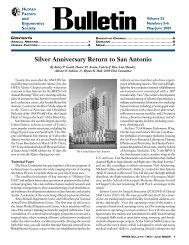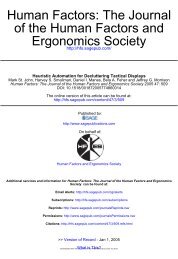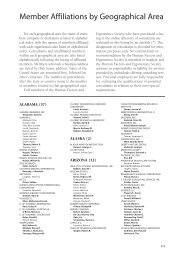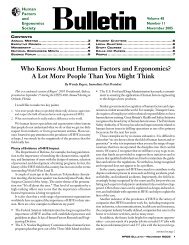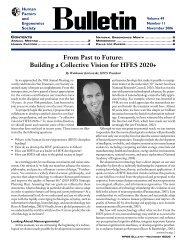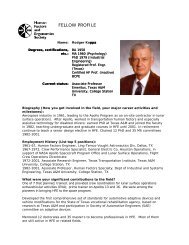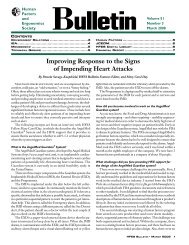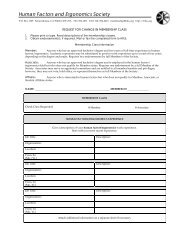Next Generation Air Transportation System Integrated Plan
Next Generation Air Transportation System Integrated Plan
Next Generation Air Transportation System Integrated Plan
Create successful ePaper yourself
Turn your PDF publications into a flip-book with our unique Google optimized e-Paper software.
Chapter 4: Operational Concepts<br />
The <strong>Next</strong> <strong>Generation</strong> <strong>Air</strong> <strong>Transportation</strong> <strong>System</strong> (NGATS) will be<br />
well equipped to adapt to future demands by using new concepts,<br />
technologies, networks, policies, and business models. <strong>Air</strong><br />
traffic control will be integrated using its ability to share timely,<br />
accurate, and secure information with a common operational<br />
picture.<br />
Multi-layered systems with up-to-the-minute information and<br />
new technologies will ensure America’s security. The safety of air<br />
travel will be designed into every air transportation component.<br />
<strong>Air</strong>ports will ensure convenience and security for travelers and<br />
shippers while increasing capacity. The air transportation system<br />
will take full advantage of enhanced aircraft<br />
performance capabilities, but it will also<br />
accommodate aircraft with less sophisticated<br />
equipage and different performance<br />
characteristics. Improvements in air traffic<br />
management systems will result from employing<br />
advanced information management technology,<br />
enhanced sensor and detection capabilities,<br />
upgraded aircraft performance capabilities, and<br />
more accurate and tailored weather forecasts.<br />
4.1 Security Operations<br />
The future air transportation system will be<br />
designed with security measures embedded and interwoven<br />
throughout the system. Security systems will operate seamlessly<br />
across all aspects of air transportation. <strong>Air</strong>port security screening will<br />
be non-intrusive and integrated with other airport-based processes<br />
such as check-in, customs, immigration, agriculture screening,<br />
manifest processing, and load planning.<br />
Passenger screening will begin well before arrival with the<br />
implementation of new, reliable, unobtrusive, and more accurate<br />
forms of identification. To achieve the desired level of security,<br />
passenger and baggage identification and security detection systems<br />
will employ cheaper, smaller, and faster technologies. In addition,<br />
security systems employed for air transportation will be integrated<br />
across other modes of transportation.<br />
Command and control protocols will be established, allowing<br />
agencies to retain responsibility while enabling a coordinated<br />
national response for protecting the homeland against all threats.<br />
Law enforcement and other agencies responsible for the nation’s<br />
security must have access to a common integrated operating picture<br />
via secure data link, air-to-ground communication systems, and<br />
airborne internet. This common operating picture permits secure<br />
and accurate communication among command and control entities.<br />
Information must flow freely to establish and monitor continuity<br />
of operations within the air transportation system. Position<br />
and intent information received from individual aircraft needs<br />
to be fully integrated with surveillance systems that will create<br />
a national surveillance network which will support homeland<br />
security and national defense needs, as well as the needs of air<br />
traffic management. This new model ensures that when an object<br />
is detected on the ground or within the airspace, information<br />
about that object will be made available to the correct agency.<br />
This enables a coordinated response from appropriate authorities.<br />
Distribution, process, correlation, and display systems enhance the<br />
quality of a common operating picture that will<br />
quickly identify abnormal deviations, erratic or<br />
errant behavior, and transfer information to the<br />
appropriate authorities.<br />
Security strategies will be tailored to address<br />
a wider range of threats, considering cost and<br />
impact on operations, and ensuring that security<br />
solutions are balanced. New systems will mitigate<br />
impacts of chemical, biological, radiological,<br />
and nuclear threats. Sensor technology and<br />
countermeasures will be used to detect and render<br />
Man-Portable <strong>Air</strong> Defense <strong>System</strong>s ineffective.<br />
<strong>System</strong>-wide safety and security monitoring allows analysis of failure,<br />
threat, and vulnerability trends in real-time, based on data gathered<br />
throughout the system. Whenever an incident occurs, it will be<br />
quickly isolated, assessed, and managed. More precise real-time<br />
diagnoses of risk will enable air traffic flows that ensure continued<br />
access to airspace, while protecting assets and infrastructures.<br />
4.2 Safety Assurance<br />
The air transportation system in 2025 will remain the world’s safest<br />
form of transportation. However, achieving this outcome will<br />
require a new approach, one that will ensure that safety requirements<br />
are established at the front end of every aviation process to<br />
prevent accidents before they happen. A more comprehensive<br />
safety approach will be implemented by airport authorities, civil<br />
aviation authorities, air traffic service providers, aircraft equipment<br />
manufacturers, and other government agencies involved in aviation.<br />
This new approach changes the regulatory authority’s role from<br />
testing, inspecting, and certifying individual system elements<br />
to comprehensive approval and periodic audits of the safety<br />
management programs within the civil aviation industry. Safety risk<br />
management and design assurance responsibility reside squarely<br />
with the aviation industry programs. This in no way abrogates the<br />
Joint <strong>Plan</strong>ning & Development Office 11




